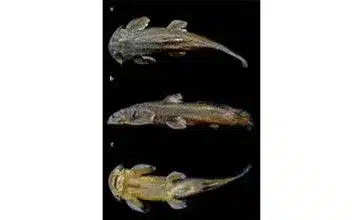About Exostoma sentiyonoae:
- According to the research paper, the species can be distinguished by several unique characteristics including an adipose fin attached to the upper procurrent caudal-fin rays, tubercles on the dorsal-fin spine, a slender head, a long distance between the dorsal and adipose fins, small eyes and 41 vertebrae.
- The researchers distinguished Exostoma sentiyonoae from its congeners in the Salween drainage of Myanmar and Thailand, specifically E. berdmorei and E. gaoligongense.
- E. sentiyonoae differs from E. berdmorei in having a shorter dorsal-fin base, a longer dorsal-adipose distance, and a smaller eye and compared to E. gaoligongense, the new species has a shorter pectoral-pelvic distance and a smaller eye.
- It marks the fourth species of Exostoma described from the Barak drainage, highlighting the region’s rich biodiversity.
- It is the first known member of this genus discovered from the Dzuleke River in Nagaland.
The Bark system:
- The Barak is the second largest river in the Northeast India after the Brahmaputra.
- Origin: it originates as a small stream amidst the lofty hills covered by thick forests of Liyai village in the Poumai territory of Manipur.
- It has a length of about 900 km of which, 564 km fall in India.
- Drainage:
- The river runs through Manipur, Nagaland, Mizoram, Assam in India and Bangladesh.
- The stream is later joined by Deirii stream and Makhan stream as it flows down south through the Biiso valley.
- The Khiiri stream joins the Barak River before reaching Karong.
- After crossing the Maram region, the Barak flows southwards into the Zeme, Liangmai and Rongmei territories of Manipur and Nagaland.
- Finally, Barak flows into Bangladesh to join the Brahmaputra and Ganga.
Q1) What is the Zoological Survey of India (ZSI)?
The Zoological Survey of India (ZSI) was established on 1st July, 1916 to promote survey, exploration and research leading to the advancement in our knowledge of various aspects of exceptionally rich life of the erstwhile ´ British Indian Empire ´ . The survey has its genesis in the establishment of the Zoological Section of the Indian Museum at Calcutta in 1875.
Source: New species of catfish discovered in Dzuleke River, Nagaland » MokokchungTimes.com
Last updated on December, 2025
→ Check out the latest UPSC Syllabus 2026 here.
→ Join Vajiram & Ravi’s Interview Guidance Programme for expert help to crack your final UPSC stage.
→ UPSC Mains Result 2025 is now out.
→ UPSC Notification 2026 is scheduled to be released on January 14, 2026.
→ UPSC Calendar 2026 is released on 15th May, 2025.
→ The UPSC Vacancy 2025 were released 1129, out of which 979 were for UPSC CSE and remaining 150 are for UPSC IFoS.
→ UPSC Prelims 2026 will be conducted on 24th May, 2026 & UPSC Mains 2026 will be conducted on 21st August 2026.
→ The UPSC Selection Process is of 3 stages-Prelims, Mains and Interview.
→ UPSC Result 2024 is released with latest UPSC Marksheet 2024. Check Now!
→ UPSC Prelims Result 2025 is out now for the CSE held on 25 May 2025.
→ UPSC Toppers List 2024 is released now. Shakti Dubey is UPSC AIR 1 2024 Topper.
→ UPSC Prelims Question Paper 2025 and Unofficial Prelims Answer Key 2025 are available now.
→ UPSC Mains Question Paper 2025 is out for Essay, GS 1, 2, 3 & GS 4.
→ UPSC Mains Indian Language Question Paper 2025 is now out.
→ UPSC Mains Optional Question Paper 2025 is now out.
→ Also check Best IAS Coaching in Delhi

















